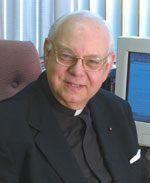Feast of Christ the King / Msgr. Owen F. Campion
The Sunday Readings
 The Second Book of Samuel furnishes the first biblical reading for this feast marking the close of the Church’s year.
The Second Book of Samuel furnishes the first biblical reading for this feast marking the close of the Church’s year.
Once, the two books of Samuel composed a single volume. In time, editors divided the volume into the two books now seen in Bibles.
These books record the major events of the reign of King David in Israel from 1004 B.C. to 971 B.C., and are classified as historical accounts in the Old Testament.
In this weekend’s reading, David becomes the king of Israel. He was more than a governmental authority or political figure. His task as king was to strengthen the union between God and the people.
He was God’s instrument, but not in a plan to control people. People have free will, which allows them to choose the course of their actions.
Rather, David was God’s gift to the people. By bringing the people more closely to God, David helped guide them to lives of peace and prosperity.
For its second reading, the Church presents a passage from St. Paul’s Epistle to the Colossians.
This epistle was written to the Christians of Colossae, a moderately important city of the Roman Empire.
Jesus is the absolute keystone of creation. In the Lord, all human beings, and certainly all Christians, come together.
Through Jesus, all people possess the hope of eternal salvation. Through Jesus, all Christians share in the very life of God.
Magnificent in its imagery, this reading acclaims Jesus as the “image of the invisible God.”
St. Luke’s Gospel supplies the last reading.
It is a passage from St. Luke’s powerful Passion Narrative, which recounts the trial and execution of Jesus.
Central in the story is the inscription placed above the head of Jesus on the cross. It read, “The King of the Jews.” It is easy, and probably accurate, to assume that this inscription was placed on the cross above the Lord’s dying body by the Roman authorities to warn observers, and potential rebels, that such was the plight of anyone who dared to defy Rome.
However, it was instead a revelation. It situated Jesus in the full sweep of Salvation history, the pattern of encounters between God and the Hebrews. Jesus was of the Hebrews. He was a Jew. Most importantly, Jesus was the first among the Jews. He was the king.
The Gospel then gives the story of the two criminals being executed beside Jesus. One man bitterly blasphemes God. The other man beautifully professes Jesus as the Savior. To him, Jesus promises life eternal. It is a majestic act of divine love and forgiveness.
Reflection
Fifty-one weeks ago, the Church began its liturgical year with Advent 2009. Then it called us to prepare ourselves to meet Jesus in our hearts.
It rejoiced with the Lord’s birth. It led us through the Lord’s Passion. It proclaimed the Resurrection. It invited us to be one in the Spirit, in the Church.
It constantly has summoned us to faith and to faithfulness, asking us to be disciples, which is no easy task, but that goal is possible because of God’s grace.
This grace awaits us because Jesus died for us. He is one of us, a human being born as the son of Mary.
A great heroine during the Second World War was Queen Wilhelmina of The Netherlands, who had come to the throne as a very small child when her father died.
On a great Dutch holiday early in her reign, her mother led Wilhelmina to the balcony of the palace to receive the cheers of the crowds. Thrilled with it all, the little queen asked, “Mommie, do all these people belong to me?”
Her mother replied, “No, dear, you belong to them.”
Wilhelmina never forgot her mother’s wise lesson.
The great lesson of this feast is that the wonderful, loving and forgiving Son of God, Christ the King, belongs to us. †
 The Second Book of Samuel furnishes the first biblical reading for this feast marking the close of the Church’s year.
The Second Book of Samuel furnishes the first biblical reading for this feast marking the close of the Church’s year.